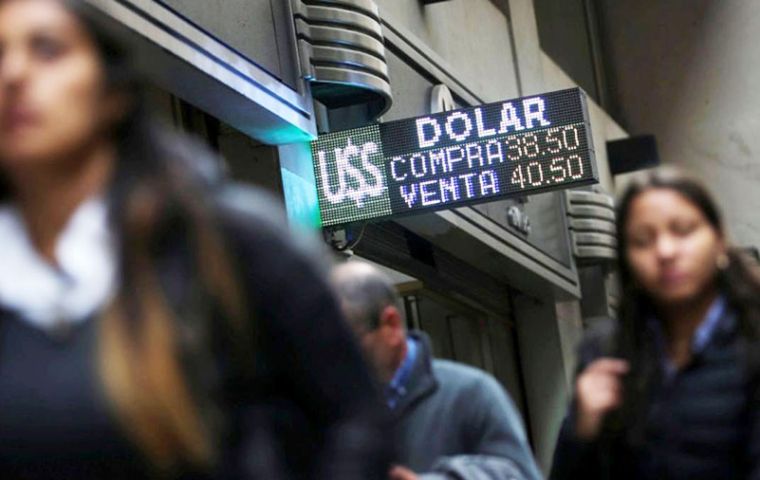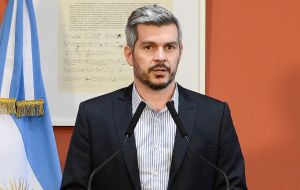MercoPress. South Atlantic News Agency
Argentine Peso strengthened for the third straight day on Friday
 The Argentine currency rose 2.6% to close at $ 37.28 per U.S. dollar on Friday, benefiting from dollar inflows attracted by interest rates about 50%
The Argentine currency rose 2.6% to close at $ 37.28 per U.S. dollar on Friday, benefiting from dollar inflows attracted by interest rates about 50%  Apparently the Central bank will set a currency band, and will buy or sell U.S. dollars when the peso reaches a ceiling or a floor
Apparently the Central bank will set a currency band, and will buy or sell U.S. dollars when the peso reaches a ceiling or a floor  Cabinet chief Marcos Peña was pictured next to Senator Miguel Angel Picetto, head of the opposition, apparently working together in Congress on the budget bill
Cabinet chief Marcos Peña was pictured next to Senator Miguel Angel Picetto, head of the opposition, apparently working together in Congress on the budget bill Argentina’s peso strengthened for the third straight day on Friday, driven by optimism that the government would sign a revised financing deal with the International Monetary Fund to include stricter fiscal measures and faster cash disbursements.
In effect the currency rose 2.6% to close at 37.28 per U.S. dollar on Friday, benefiting from dollar inflows as investors piled into Treasury notes offered this week at interest rates about 50%. The peso gained 6.95% since Monday, after losing about half its value so far this year.
The change of mood in markets was also boosted by the imminent agreement with the International Monetary Fund on the standby credit and disbursements. Apparently according to Buenos Aires media reliable sources the Central bank will set a currency band in an effort to stabilize the currency. The bank will buy or sell U.S. dollars when the peso reaches a ceiling between 40 and 44 pesos per U.S. dollar or a floor between 32 and 36 pesos per U.S. dollar.
Argentina's government and the IMF team which spent a week in Buenos Aires were hammering out details for the new package that will apparently be increased by US$ 20bn from the original US$ 50bn with the purpose of having he central bank hold on to its foreign currency reserves.
Likewise the 2019 austere budget presented to Congress, including several reforms, should be approved with not much discussions given a political agreement with the opposition, the terms of which are not entirely known. However the cabinet chief Marcos Pe;a, and of extreme confidence of President Mauricio Macri, had a picture taken next to Senator Miguel Angel Picetto, head of the opposition, apparently working together in Congress.
The budget bill offers additional spending cuts and tax hikes as the path to fiscal equilibrium.
President Macri is scheduled to fly this weekend to the United States for the coming UN annual assembly next week, and the round of political and business contacts, which includes US president Donald Trump, and IMF chief Christine Lagarde, both strong supporters of a stable Argentina.
The peso sell-off started in May, driven by doubts about the central bank’s ability to roll over its growing stock of short-term ‘Lebac’ notes. The economy has since slipped into recession, with inflation at more than 40%.
Macri took office in late 2015 and swiftly ditched the heavy-handed currency controls favored by his populist predecessor Cristina Fernandez. He promised that his orthodox policies would put an end to the cyclical financial crises that have bedeviled Argentina over the last 60 years.
The last meltdown of Latin America’s No. 3 economy, in 2002, tossed millions of middle-class Argentines into poverty, and the blame went mostly to the IMF.
Macri has cut public utility subsidies as part of his fiscal push. This has saved the government money but also contributed to inflation by pushing household electricity bills higher. More subsidy reductions are expected before the end of the year, which will further jack up utility rates paid by consumers.




Top Comments
Disclaimer & comment rules-

-

-

Read all commentsWhere are the starving aliens here?
Sep 22nd, 2018 - 01:57 pm 0Just a few minutes of sunshine before the new clouds arrive
Sep 22nd, 2018 - 04:24 pm 0Quote: “The last meltdown of Latin America’s No. 3 economy, in 2002, tossed millions of middle-class Argentines into poverty, and the blame went mostly to the IMF.”
Sep 23rd, 2018 - 06:03 pm 0Yep.
In Argentina it's always somebody else's fault.
Commenting for this story is now closed.
If you have a Facebook account, become a fan and comment on our Facebook Page!